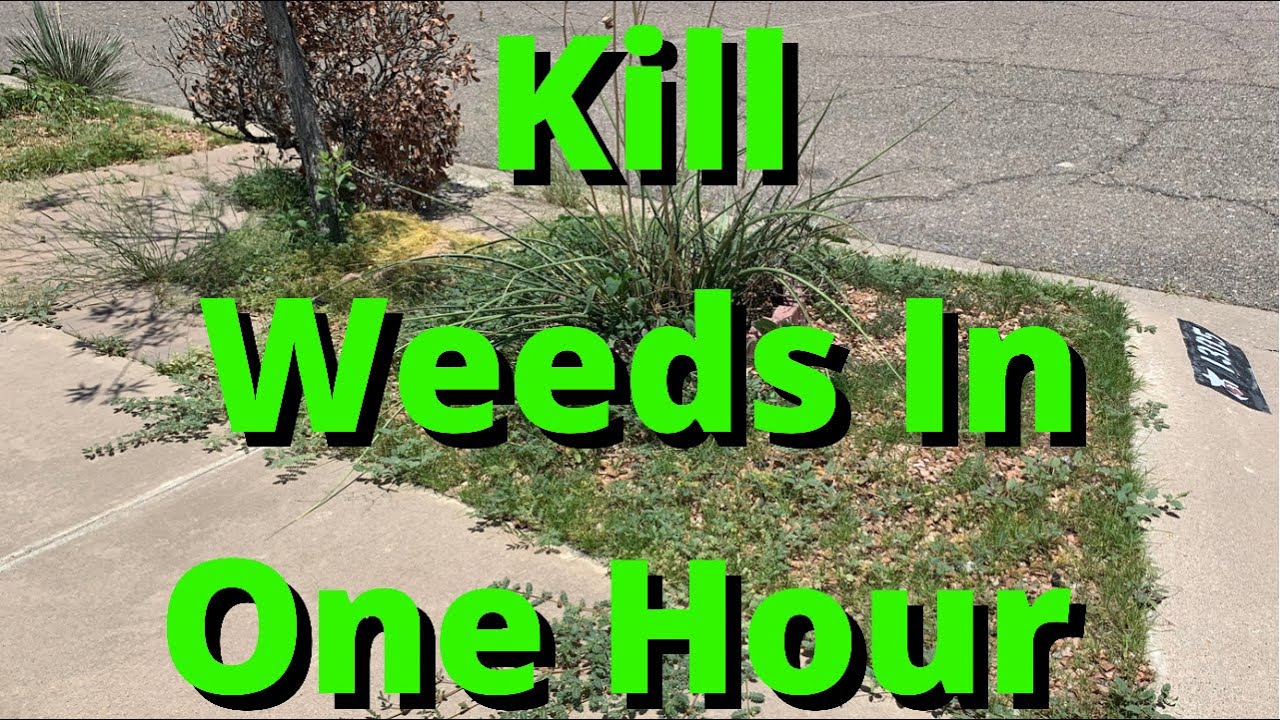To get rid of weeds in desert landscaping, apply mulch or gravel to block sunlight. Regularly pull weeds by hand or use an appropriate herbicide.
Desert landscaping offers beauty and sustainability, but weeds can disrupt its harmony. These unwanted plants compete for water and nutrients, making effective weed control essential. A proactive approach helps maintain the aesthetic appeal and health of your garden. Techniques like mulching, hand-pulling, and targeted herbicide use can significantly reduce weed growth.
Knowing which weeds commonly invade desert landscapes can help you tackle them more effectively. With the right strategies, you can enjoy a thriving, weed-free oasis in your outdoor space. Embrace these methods for a vibrant and manageable landscape.

Credit: www.reddit.com
How to Get Rid of Weeds in Desert Landscaping : Step by Step Guide
Desert landscaping presents unique challenges, especially with weeds. These resilient plants thrive in extreme conditions. They compete with your desired plants for water and nutrients. Understanding this issue is crucial for maintaining a beautiful garden.
Unique Conditions Of Desert Gardens
Desert gardens have specific conditions that affect plant growth. Here are key factors to consider:
- Low Rainfall: Limited water supply encourages weed growth.
- High Temperatures: Extreme heat can stress plants.
- Soil Type: Sandy or rocky soils may not retain moisture.
- Sun Exposure: Full sunlight can make plants vulnerable.
These factors create an ideal environment for weeds. They can spread quickly and take over your garden.
Why Weeds Are A Problem
Weeds pose several problems in desert landscapes. Here are some major issues:
- Competition: Weeds compete for limited water and nutrients.
- Overgrowth: They can quickly dominate garden space.
- Disease Vectors: Weeds can harbor pests and diseases.
- Aesthetic Issues: Weeds can ruin the beauty of your garden.
Effective weed management is essential for a thriving desert landscape. Regular maintenance and awareness can make a significant difference.
Identifying Common Desert Weeds
Identifying common desert weeds is essential for effective landscaping. Weeds can compete with your plants for nutrients and water. Knowing what to look for helps in managing them.
Characteristics Of Desert Weeds
Desert weeds have unique traits that help them survive in harsh conditions. Here are some key characteristics:
- Drought Resistance: They thrive with little water.
- Fast Growth: Many grow quickly to outcompete other plants.
- Seed Production: They produce a lot of seeds to spread easily.
- Adaptability: These weeds can survive in poor soil.
Most Common Types
Several weeds commonly invade desert landscapes. Here are the most frequent types:
| Weed Name | Identification Features |
|---|---|
| Bindweed | Creeping vines with white or pink flowers. |
| Purslane | Succulent leaves, yellow flowers, low growth habit. |
| Crimson Clover | Bright red flowers, grows in clumps. |
| Yellow Salsify | Long stems with yellow dandelion-like flowers. |
| Cheatgrass | Thin, green blades that turn brown when dry. |
Identifying these weeds early helps in controlling them. Regular monitoring of your landscape keeps your plants healthy. Stay vigilant to maintain a beautiful desert garden.
Preventative Measures Against Weeds
Weeds can ruin the beauty of your desert landscape. Preventing weeds saves time and effort. Here are effective strategies to keep them at bay.
Choosing The Right Ground Cover
Selecting the right ground cover plants is key to weed control. These plants can outcompete weeds for resources.
- Native Plants: Use plants native to your area. They thrive in local conditions.
- Drought-Resistant Varieties: Choose plants that need less water. They are ideal for desert climates.
- Fast-Growing Species: Select species that grow quickly. They cover the soil and block weeds.
Here’s a quick table of some great ground cover options:
| Plant Name | Benefits |
|---|---|
| Desert Marigold | Attractive yellow flowers, drought-resistant |
| Trailing Rosemary | Fragrant, low maintenance |
| Red Yucca | Beautiful blooms, hardy in heat |
Mulching Techniques
Using mulch is an excellent way to prevent weeds. Mulch blocks sunlight and keeps soil moist.
- Types of Mulch:
- Organic Mulch: Bark, straw, or wood chips.
- Inorganic Mulch: Gravel or rocks.
- Application Depth:
- Apply 2 to 4 inches of mulch.
- Keep it away from plant stems.
- Replenishing Mulch: Refresh mulch every year. This keeps it effective.
These mulching techniques create a healthier landscape. They reduce weeds and enhance soil moisture.

Credit: www.reddit.com
Natural Weed Removal Methods
Weeds can disrupt the beauty of your desert landscaping. Using natural methods is safe for the environment. Here are effective ways to control weeds without chemicals.
Hand Pulling
Hand pulling is a straightforward technique. It works best for small infestations. Follow these steps for effective hand pulling:
- Wear gardening gloves.
- Moisten the soil to loosen the weeds.
- Grip the base of the weed and pull upwards.
- Ensure you remove the entire root.
- Dispose of the weeds properly.
Hand pulling is labor-intensive but very effective. It prevents weeds from spreading.
Boiling Water Technique
The boiling water method is simple and effective. Boiling water can kill weeds instantly. Here’s how to do it:
- Boil a pot of water.
- Carefully pour the boiling water directly onto the weeds.
- Make sure to avoid your desired plants.
This technique works best on sunny days. The heat penetrates the plant tissues. It causes the weeds to wilt and die.
| Method | Effectiveness | Best For |
|---|---|---|
| Hand Pulling | High | Small areas |
| Boiling Water | Immediate | Spot treatment |
Both methods require little investment. They promote a healthy, beautiful landscape. Choose the method that fits your needs best.
Chemical Solutions For Persistent Weeds
Dealing with persistent weeds in desert landscaping can be tough. Chemical solutions offer effective ways to control these unwanted plants. Using the right herbicides can protect your landscape. Targeting specific weeds ensures your plants thrive.
Types Of Herbicides
Choosing the right herbicide is key. Here are some common types:
| Herbicide Type | Description |
|---|---|
| Pre-emergent | Stops weed seeds from germinating. |
| Post-emergent | Kills weeds that have already sprouted. |
| Selective | Targets specific weeds without harming other plants. |
| Non-selective | Kills all plants it touches. |
Application Tips
Proper application of herbicides boosts their effectiveness. Follow these tips:
- Apply on a calm, dry day.
- Use a sprayer for even coverage.
- Wear protective clothing and gear.
- Read labels for dosage and instructions.
- Keep pets and children away during application.
Monitor the area after application. Look for any signs of new growth. Reapply as needed to keep your landscape healthy.

Credit: janemming.com
Innovative Tools And Equipment
Weeds can quickly ruin your desert landscaping. Using the right tools makes removal easier. Innovative equipment can save time and energy. Here are essential tools for effective weed control.
Weed Extraction Tools
Weed extraction tools come in various designs. Choose tools that suit your landscape needs. Here are some popular options:
- Hand Weeders: Perfect for small areas and stubborn weeds.
- Garden Hoes: Great for breaking up soil and uprooting weeds.
- Weed Pullers: Ideal for deep-rooted weeds, minimizing soil disturbance.
- Flame Weeders: Use heat to kill weeds without chemicals.
Each tool has unique benefits. Select the one that fits your garden’s size. Using the right tool helps maintain your landscape’s beauty.
Protective Gear
Safety is crucial while dealing with weeds. Wear protective gear to prevent injuries. Here are some essential items:
- Gloves: Protect your hands from thorns and irritants.
- Goggles: Shield your eyes from debris and dust.
- Long Sleeves: Prevent skin irritation from plants.
- Sturdy Boots: Ensure safety while walking in rough terrain.
Wearing protective gear enhances your comfort. It allows you to focus on effective weed removal. Stay safe while enjoying your gardening tasks.
Creating A Weed Management Plan
A well-structured weed management plan is essential for desert landscaping. It helps maintain a healthy garden while reducing unwanted plants. Implementing this plan involves regular monitoring and seasonal approaches.
Regular Monitoring
Regularly checking your landscape can prevent weed growth. Follow these steps for effective monitoring:
- Inspect your garden weekly.
- Identify weeds early.
- Assess the health of your plants.
Use a notebook to track observations. Note locations of weeds and their types. This will help you plan your next steps.
Seasonal Approaches
Seasons affect weed growth. Tailor your strategies to each season:
| Season | Weed Management Strategy |
|---|---|
| Spring | Apply mulch to suppress weeds. |
| Summer | Water deeply and less often. |
| Fall | Remove weeds before winter. |
| Winter | Plan for the next growing season. |
Implement these strategies to maintain a beautiful landscape. Regular actions lead to long-term results.
Maintaining Your Desert Landscape Post-weed Removal
After removing weeds, proper maintenance is crucial. This helps your desert landscape thrive. Focus on replanting and long-term prevention strategies. Here’s how you can effectively maintain your landscape.
Replanting With Native Plants
Replanting is essential after weed removal. Native plants are ideal for desert landscapes. They adapt well to the dry climate and require less water.
- Benefits of Native Plants:
- Low water needs
- Attracts local wildlife
- Reduces the risk of weeds
- Popular Native Plants:
- Desert Marigold
- Red Yucca
- Agave
- Desert Sage
Choose plants that fit your local environment. This encourages a healthy ecosystem.
Long-term Weed Prevention Strategies
Preventing weeds is crucial for your landscape’s health. Here are effective strategies:
| Strategy | Description |
|---|---|
| Mulching | Use organic mulch to block sunlight and suppress weeds. |
| Regular Monitoring | Check for weeds weekly. Remove any new growth immediately. |
| Proper Watering | Water only your plants. Avoid wetting areas where weeds grow. |
| Soil Health | Add organic matter to improve soil quality. Healthy soil grows strong plants. |
Implement these strategies consistently. This will keep your desert landscape healthy and beautiful.
Frequently Asked Questions
How Can I Prevent Weeds In Desert Landscaping?
To prevent weeds, start with a thick layer of mulch. Use gravel or wood chips, which reduce sunlight and hinder weed growth. Regularly check for emerging weeds and remove them promptly. Healthy plants will also outcompete weeds for resources, making prevention easier.
What Are Effective Weed Removal Methods?
Effective weed removal methods include hand-pulling, hoeing, and using organic herbicides. Hand-pulling is best for small patches, while hoeing works well for larger areas. Organic herbicides can target weeds without harming your desert plants. Always follow the manufacturer’s instructions for best results.
When Is The Best Time To Remove Weeds?
The best time to remove weeds is during their early growth stages. Young weeds are easier to pull out and less likely to spread seeds. Regular maintenance in spring and fall can effectively control weed populations. Consistency is key to maintaining a weed-free landscape.
Are There Specific Tools For Weed Removal?
Yes, several tools can help with weed removal in desert landscaping. Hand tools like weeding forks and trowels are effective for small areas. For larger spaces, consider using a hoe or a weed torch. These tools make the process easier and more efficient for maintaining your garden.
Conclusion
Maintaining a weed-free desert landscape is essential for healthy plants. Regularly monitor your garden for new weeds. Use mulch and proper watering techniques to deter growth. Organic herbicides can also be effective. With consistent care, your desert garden will thrive, showcasing its natural beauty without the hassle of pesky weeds.

